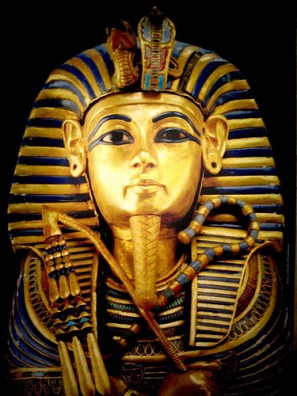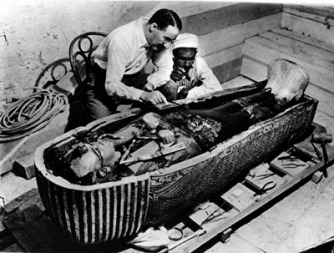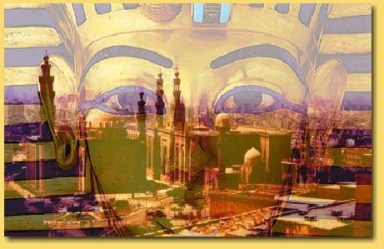Ancient Egypt
King Tut

King Tut, whose actual name is Tutankhamen ,was the twelfth king of the eighteenth Egyptian dynasty (reigned 1361–1352 B.C.E. ). He was born in 1343 BC in Armana.Little is known of Tutankhamen's childhood. Historian believe Tutankhamen was the son of either Amenophis III or Akhenaten. His mother was Nefertiti.
Tutankhamen was only a child when he became king, for although he reigned eight full years, examination of his body has shown that he was little more than eighteen years old at the time of his death. The cause of Tutankhamen's death is unknown, although, due to skull damage found in his remains, many believe he was assassinated. Newer discoveries today reveal that he may have died from malaria and a rare bone disease.
Tutankhamen became the most famous of the pharaohs when his treasure-filled tomb was discovered in the early twentieth century. The vast and untouched contents of his tomb offered historians great insight into the ancient Egyptian culture.
The tomb room contained more than five thousand objects, many of which were covered with gold and beautifully carved. The most famous of these objects is probably the lifelike gold mask that covered the face of Tutankhamen's mummy. Carter also uncovered military items, clothing, jewelry, and many statues of Tutankhamen and Egyptian gods. In fact, there were so many items in the tomb that many are still being examined today and have yet to be displayed in museums—nearly eighty years after their discovery.
Tutankhamen was only a child when he became king, for although he reigned eight full years, examination of his body has shown that he was little more than eighteen years old at the time of his death. The cause of Tutankhamen's death is unknown, although, due to skull damage found in his remains, many believe he was assassinated. Newer discoveries today reveal that he may have died from malaria and a rare bone disease.
Tutankhamen became the most famous of the pharaohs when his treasure-filled tomb was discovered in the early twentieth century. The vast and untouched contents of his tomb offered historians great insight into the ancient Egyptian culture.
The tomb room contained more than five thousand objects, many of which were covered with gold and beautifully carved. The most famous of these objects is probably the lifelike gold mask that covered the face of Tutankhamen's mummy. Carter also uncovered military items, clothing, jewelry, and many statues of Tutankhamen and Egyptian gods. In fact, there were so many items in the tomb that many are still being examined today and have yet to be displayed in museums—nearly eighty years after their discovery.
The Discovery of Tutankhamun

The mummy of King Tut was found in 1922 by Howard Carter and Lord Carnarvon. Lord Carnarvon was a rich man who owned the right to dig in the Valley of the Kings where Tutankhamun was found. Lord Carnarvon was letting Carter dig for a king named Tutankhamun who's name Carter had read on some stone walls. Howard Carter and Lord Carnarvon searched for five years for Tutankhamun in the valley of the kings yet they found nothing. Lord Carnarvon was giving up hope after five years, so Carter offered to pay for the workers, and Lord Carnarvon agreed to this. After four days of work under Carter's pay they found the steps leading to the entrance to the tomb. It took Lord Carnarvon two weeks to get from England to the valley of the kings. When Lord Carnarvon got to the scene they began futher excavation.
The first room they came to was a fake and it had a hidden door that led to the main chamber. From the main chamber two rooms split off. There was a storage room and the burial chamber where the mummy was laid. Many people died of the so-called curse on King Tut's tomb but we now know that bacteria sealed in the tomb fed on the food in the tomb and killed the workers when it got in their lungs. Carter said later "As my eyes grew accustomed to the light I was struck dumb with amazement". A winged scarab beetle spells out the hieroglyphs " Neb, Kheperu and Re" which mean Tutankhamun.
The first room they came to was a fake and it had a hidden door that led to the main chamber. From the main chamber two rooms split off. There was a storage room and the burial chamber where the mummy was laid. Many people died of the so-called curse on King Tut's tomb but we now know that bacteria sealed in the tomb fed on the food in the tomb and killed the workers when it got in their lungs. Carter said later "As my eyes grew accustomed to the light I was struck dumb with amazement". A winged scarab beetle spells out the hieroglyphs " Neb, Kheperu and Re" which mean Tutankhamun.
King Tut Revealed
Does the curse exist?

The Curse of the King
The curse of the mummy began when many terrible events occurred after the discovery of King Tut's tomb. Legend has it that anyone who dared to open the tomb would suffer the wrath of the mummy. It wasn't until the discovery of King Tut and the hype of the media that things would change forever.
The hype began when Lord Carnarvon, the person who funded the discovery of King Tut’s Tomb, died shortly after the discovery. The path to his death began in the spring of 1923 when he was bitten on the cheek by a mosquito. During his morning shaving routines, he further aggravated the mosquito bite. It soon became infected and Lord Carnarvon found himself ill. He suffered a high fever and chills. A doctor was sent to examine him but medical attention arrived too late and Lord Carnarvon died. At that exact moment the lights in Cairo mysteriously went out.
Once Carnarvon died the media went wild with stories of his death. They claimed King Tut wanted vengeance and announced a mummy's curse, which targeted those who had entered the tomb. Not only did the death of Carnarvon get all the people in an uproar but other stories began to surface as well.
Did King Tut's Tomb really unleash a curse? New findings are showing that bacteria on the wall of the tomb might have been the cause of the curse. The bacteria would release spores into the air allowing it to be breathed. This in turn caused people who came into contact with these spores to become ill.
The myth of the curse has remained with King Tut and continues to make people question as to whether the curse was really unleashed. . Do you believe in the curse of the mummy?
The curse of the mummy began when many terrible events occurred after the discovery of King Tut's tomb. Legend has it that anyone who dared to open the tomb would suffer the wrath of the mummy. It wasn't until the discovery of King Tut and the hype of the media that things would change forever.
The hype began when Lord Carnarvon, the person who funded the discovery of King Tut’s Tomb, died shortly after the discovery. The path to his death began in the spring of 1923 when he was bitten on the cheek by a mosquito. During his morning shaving routines, he further aggravated the mosquito bite. It soon became infected and Lord Carnarvon found himself ill. He suffered a high fever and chills. A doctor was sent to examine him but medical attention arrived too late and Lord Carnarvon died. At that exact moment the lights in Cairo mysteriously went out.
Once Carnarvon died the media went wild with stories of his death. They claimed King Tut wanted vengeance and announced a mummy's curse, which targeted those who had entered the tomb. Not only did the death of Carnarvon get all the people in an uproar but other stories began to surface as well.
Did King Tut's Tomb really unleash a curse? New findings are showing that bacteria on the wall of the tomb might have been the cause of the curse. The bacteria would release spores into the air allowing it to be breathed. This in turn caused people who came into contact with these spores to become ill.
The myth of the curse has remained with King Tut and continues to make people question as to whether the curse was really unleashed. . Do you believe in the curse of the mummy?
